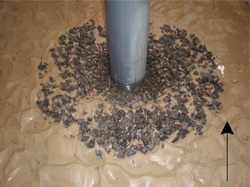 Scour - the movement of sediment that can erode the seabed around a fixed structure – is one of the major concerns when designing offshore wind turbine foundations. Indeed, turbine foundations are more susceptible to scour than predicted, as shown by Anders Wedel Nielsen, who recently joined our team in Denmark.
Scour - the movement of sediment that can erode the seabed around a fixed structure – is one of the major concerns when designing offshore wind turbine foundations. Indeed, turbine foundations are more susceptible to scour than predicted, as shown by Anders Wedel Nielsen, who recently joined our team in Denmark.
The most common strategy to date for scour protection is to place stones on the seabed around foundations. This method was also used for the 160 MW Horns Rev 1 offshore wind farm located off Denmark’s west coast. A control survey in 2005 revealed erosion: the scour protections had sunk up to 1.5 m adjacent to the foundations. The sinking was unexpected and large enough to expose cables at some of the turbines. To prevent damage to the cables and further sinking, the scour holes were filled with additional stones.
A Ph.D-project at DTU, financed by DHI, Statkraft and the Danish Strategic Research Council, revealed the cause of the erosion: horseshoe vortices, well known for causing scour around unprotected structures, had been strong enough to penetrate into the scour protection and wash out the sediment, causing the sinking of the stones. That can reduce the stability of the monopile, as Nielsen – lead author of the related publication - points out.
Now that the causes of erosion are known, it is possible to predict the sinking of the scour protection around a foundation and take it into account already in the design phase. Then, scour is no longer a threat but just one more factor that needs to be accounted for in the best and cheapest way. Possible solutions are insertion of a filter layer of finer-grade stones, regular topping up of the scour protection, installation of unprotected monopile foundations in selected locations, or the use of different pile designs.
After joining DHI in September 2011, Nielsen now investigates predictive models that would help forecast the likely long-term impact of scour on unprotected monopile foundations. With the results at hand, the existing affected wind farms will be able to adjust to the erosion problem. Future windfarm generations will profit already in the design stage. “The next generation of wind farms in relatively shallow water can optimise the layout of the development and the overall design — and so hopefully save the developer some money,” says Nielsen.
The movie shows a part of the upstream side of the scour protection. The pile is located in the upper right corner and the incoming flow is from left to right as indicated. The blue dye is added upstream of the scour protection, while the green dye is added adjacent to the pile. The blue dye is washed in between the stones in the approach flow direction, while the green dye is washed in the opposite direction by the horseshoe vortex, as indicated by the blue and green arrows.